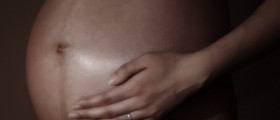
Pregnancy usually lasts between 37 weeks and 42 weeks. It is defined as the carrying of the offspring inside the womb of a female, and the childbirth usually occurs about 38 weeks after conception, or about 40 weeks from the last normal menstrual period. Pregnancy is typically divided into three trimesters, marked by some of the most important developmental milestones of an embryo or a fetus. By the end of 37 weeks, a baby is considered full term, and this is the actual last stage of pregnancy. The organs of a baby are now ready to function on their own and a delivery may start anytime.
End stage of pregnancy
Third trimester of pregnancy is for most women very uncomfortable and full of physical annoyances and mental anxiety. As date of delivery approaches, women may be physically and emotional challenged. Women are often very tired of pregnancy and anxious to move to the next stage.
At the end, stage of pregnancy women will have nearly 2 pounds of additional breast tissue. Their breasts may start leaking yellowish fluid, known as colostrum, which is the baby’s primary food during the first couple of days of life. Women are usually very heavy and have up to 35 pounds more than they did before pregnancy.
False labor
Braxton Hicks contractions, also known as false labor or practice contractions are sporadic uterine contractions that may start to appear during the end stage of pregnancy. They are usually weak and their purpose is to prepare women for labor.
Swelling and vaginal discharge
Women will start to swell as the growing uterus puts pressure on the veins that return blood from legs. For the same reason, the pressure on the bladder is excessive and women will feel the need for more frequent urination. Fluid retention usually makes pregnant women appear puffy in the face.
Heavy vaginal discharge is also very common at the end stage of pregnancy, and it should not be confused with leaking amniotic fluid. Labor
Every woman is different and labor is sometimes a matter of minutes while in other cases it can prolong to a couple of hours. The first stage of labor occurs when the cervix opens and the baby moves into the birth canal. When the cervix opens, women will start feeling contractions that last 30 to 90 seconds and come at regular intervals. Thick and blood–tinged discharge will start leaking from the vagina. At the next stage, the cervix dilates to 10 centimeters, and women start feeling increasing pressure as the baby moves into the birth canal. This stage often lasts up to eight hours. The last part of labor is particularly intense and takes anywhere from few minutes up to several hours before the baby's head is delivered.

















Your thoughts on this
Loading...